Edison Ford Visitors Recognize Active Duty Military Personnel
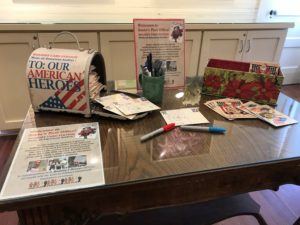 During this year’s Holiday Nights event, Edison Ford staff partnered with volunteers from the Cape Coral organization, Holiday 4 Heroes, to collect needed items and mail holiday postcards to soldiers stationed overseas.
During this year’s Holiday Nights event, Edison Ford staff partnered with volunteers from the Cape Coral organization, Holiday 4 Heroes, to collect needed items and mail holiday postcards to soldiers stationed overseas.
Visitors generously donated items soldiers are in need of, including sunscreen, lip balm, eye drops, hand and foot warmers, travel games, jerky, dried fruit, and gallon zip lock bags. Many also completed postcards and wrote messages of encouragement on a large banner, which will be mailed as well.
Thank you to the many visitors who participated!
Can you hear me now? Edison’s Talking Machine
On December 7, 1877, Thomas Edison entered the New York offices of the Scientific American, a popular scientific magazine that happened to be one of the emerging inventor’s favorite periodicals. Unlike earlier occasions, this visit was not about discussing the latest telegraph device or telegraphy’s ever evolving technology. This day was different; the young inventor found himself on the cusp of international stardom, as he had in his possession a machine that could talk– the very first of its kind!
The day before in his laboratory, Edison shocked his staff when his newest creation reproduced the nursery rhyme Mary had a little lamb. The experience came as an absolute surprise, leading an ecstatic Edison to write:
“I was never was so taken back in my life. Everybody was astonished. I was always afraid of things that worked the first time.”
Inside the office, Edison’s fateful moment had arrived– could he repeat his successful demonstration from the previous day? As curious staff members gathered around his bizarre apparatus, Edison began cranking the handle, and almost immediately it began repeating the inventor’s pre-made recording. Utterly amazed, the journal’s editor later stated that “the machine inquired as to our health, asked how we liked the phonograph, informed us that it was very well, and bid us a cordial goodnight.” As a result, the indomitable young inventor from Menlo Park became the first person to both record and reproduce the human voice, a remarkable accomplish that had eluded many within the scientific community during much of the nineteenth century.
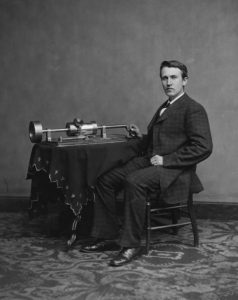
According to Curatorial Registrar, Matt Andres, the tinfoil phonograph was “very much based on Edison’s initial idea for recording and playback of telephone messages for what he called his “speaking-telegraph” machine. In fact, the two diaphragms used on Edison’s earliest version of the phonograph are a direct result of his research on the subject of telephony and acoustics.”
The machine is a rather simple device, in that it features a grooved cylinder attached to a cross-shaft with a screw pitch and was turned by a hand crank. John Kruesi, one of Edison’s top machinists, initially created two diaphragms, one for recording and another for playback based off of earlier research. Soundwaves from a person’s voice caused the recording needle to vibrate thus indenting the tinfoil. Upon playback, the second needle followed the same trajectory as the first, subsequent contact with the indentations produced vibrations that allowed the playback mechanism to reproduce the soundwaves. For several decades, scientists had been investigating a variety of complex methods to reproduce sound, so many were completely stunned when they learned about the machines sheer simplicity and relatively easy operation.
Give Some Greenery for the Holidays
While you’re out (or online) doing your holiday shopping, visit our Garden Shoppe for some unique and eco-friendly gifts for your friends and families. Our Garden Shoppe is open until 9 pm during Holiday Nights!
If you’re looking for something small, consider a glass orb or shell with an air plant. Each include a hanger so they can be added directly to a Christmas tree or hung anywhere in the house. We also have some small wreaths adorned with a large air plant and a red bow.
On the larger (and harder-to-wrap) side, the classic poinsettia is always a winner. And, poinsettias don’t just come in solid red anymore! See the photos at the bottom of the page for a glimpse at some of the color varieties we sell. As a bonus, if your recipient lives in south Florida, they can plant their poinsettia outside and enjoy your present for years. Read here for some info on the Edisons’ use of poinsettias and to find out how the plant got its name.
Of course, our Garden Shoppe is full of other Florida-friendly plants. We just received an order of bright bougainvilleas, which are a gift that keeps on giving! Bougainvilleas are easy to care for and can take a lot of neglect, so they are perfect for someone who wants a lot of color in their landscape but doesn’t want to spend a lot of time fussing over a plant. We have more than a hundred types of plants to choose from, so you’re sure to find something for everyone on your list, and maybe yourself!
Did Edison Light Up the Holidays?
Growing up, did you learn that Thomas Edison invented the light bulb? As you probably know now, the truth is that he continued the long process of innovation that many inventors before him began, refining and improving the light bulb and systems of electric lighting. His contributions enabled the light bulb to become much more widespread, ushering in the era of modern electric lighting.
Along these same lines, you may have heard that Edison invented the electric Christmas light. As you likely have guessed, the truth of this story is more complicated! Here are two important contributions Edison and his staff made to brightening the holiday season:
Christmas 1880: Strands of Edison’s light bulbs were festively strung outside his Menlo Park, New Jersey laboratory for the first time. These lights were seen by passengers on passing trains.
Christmas 1882: Edward Johnson, Edison’s partner in the Edison Illumination Company, strung red, white, and blue lights on the Christmas tree in his home. He also wired the tree to rotate!
Which of these lights would you consider to be the first electric Christmas lights?
Did you know? Many decades passed before electric Christmas lights entered mainstream American culture, primarily due to tradition and expense.
Plant Spotlight: Yesterday, Today and Tomorrow
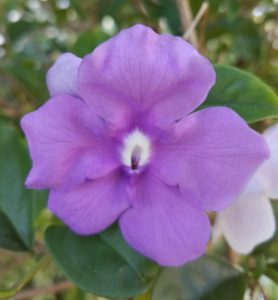
Yesterday, today and tomorrow in full purple soon after blooming at the Edison and Ford Winter Estates in Ft. Myers, Florida.
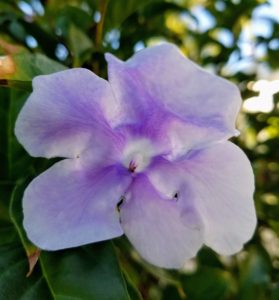
Yesterday, today and tomorrow bloom fading from purple to lavender at the Edison and Ford Winter Estates in Ft. Myers, Florida.

Yesterday, today and tomorrow fading from lavender to white at the Edison and Ford Winter Estates in Ft. Myers, Florida.
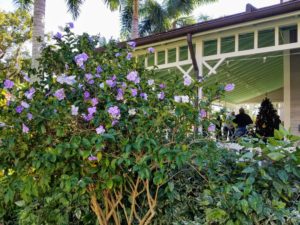
Yesterday, today and tomorrow blooming off the Guest Home porch at the Edison and Ford Winter Estates in Ft. Myers, Florida.
Not many flowers are able to change their petal color, but the yesterday, today and tomorrow (YTT), Brunfelsia grandiflora, is very good at it. This popular shrub starts out with purple blooms, which fade to lavender and then white before falling off. It can handle some cold, as low as Zone 9 in Florida, but it may lose it’s leaves until warmer weather returns. YTT may bloom anytime but it seems to be at it’s showiest as soon as our long, hot summer days end and the cooler fall weather returns. It prefers partial sun but can take full sun with sufficient irrigation. Otherwise, water it occasionally during the dry season. The YTT takes to shaping and can even be grown in containers. Come by the Estates and see the plants in action – we have a couple large shrubs between the Edison and Guest homes along the porches. If you want one for your landscape, drop by our Garden Shoppe and take one home. For more information on how to grow YTT, check out this previous post.